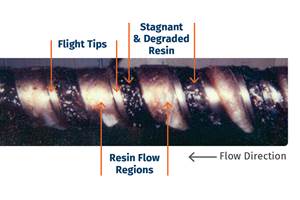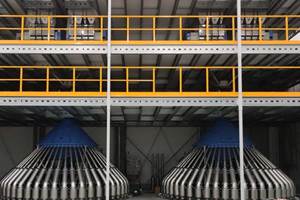NPE2018 New Technology Focus: Film & Extrusion Coating
Check out what’s new in blown and cast film and extrusion coating at the big plastics industry trade show.
Macchi (Booth W7463) is running a five-layer POD (polyolefin-dedicated), high-output line producing PE film for stand-up pouches. During the five-day show, Macchi will demonstrate the line’s capabilities to downgauge by up to 30-40%.
Windmoeller & Hoelscher (Booth W6663) is making its TurboClean automation module retrofittable to some existing W&H lines. The TurboClean system purges resin from all extruders and gravimetric hoppers simultaneously, dramatically decreasing the time required to change materials. It was introduced at K 2015, at which time it was only available on new W&H Varex II systems. Now, existing W&H Varex II and Varex I lines built in or after 2010 can be retrofitted with the module.
Hosokawa Alpine American (Booth W1971) will be touting the benefits of its X die, billed as the fastest-purging die on the market. It is offered for up to 11 layers.
Germany’s Kuhne Anlagenbau GmbH (Booth S35139) will be showing a concept Mo-Con die that is modular, streamlined, compact, and expandable.
The stackable Layer Sequence Alpha Dual Spiral Systems blown-film dies from Alpha Marathon (Booth S31167) reportedly provide superior streamlining and mixing of melt flow as well as interlayer temperature isolation. The addition of the new patented Feed Block System allows film processors to extrude two different materials in the same module to either duplicate the number of layers or introduce new materials to the film structure.
Addex Inc. (Booth W4773) is showcasing its latest Intensive Cooling technology. The “Height-Adjustable” Intensive Cooling Twin-Stack system is designed to optimize performance when processing both high- and low-melt-strength resins. The system operates over a wide range of configurations and materials, while also enhancing bubble stability. These retrofits are aimed at blown-film lines designed for higher outputs and with sufficient extruder and blower capacity to handle the output gains made possible by Intensive Cooling Twin-Stack.
Brampton Engineering (Booth W2363) is showing the Vector S air ring. Vector S offers an auto-gauge option utilizing segmented air. Thanks to extremely uniform airflow around the lip, Vector S reportedly offers the best startup gauge in the industry by reducing variability by up to 80% compared with conventional air rings.
D.R. Joseph (Booth W4383) is exhibiting a new control feature for non-IBC blown-film lines—neck-height control for medium- or high-stalk bubbles. The control system uses an ultrasonic sensor facing the bottom of the bubble flare to measure neck height, then maintains the setpoint to within ± 0.25 in. It also coordinates the competing tasks of managing layflat width and neck height during startup, hole recovery, and normal production.
D.R. Joseph is also unveiling a new generation of radial roll cages that it says completely address the shortfalls of traditional radial sizing cages. Mechanical linkages and moving parts are greatly reduced, as is overall footprint (like iris-style cages), and the total investment cost is comparable to iris-sizing cages. The unit offers processors higher precision in diameter adjustment, complete stability and bubble support at all diameter ranges, extreme rigidity with zero play or backlash, and improved IBC control with the DRJ IBC control system.
New surface winders from Macro Engineering and Technology (Booth W5763) feature a face width of 69 in. and maximum roll diameter of 3.3 ft. They offer gap winding, reverse winding, zero-fold transfer, tapered pressure and tension control, shaft extraction, electrical shaft loading, and ability to handle a wide range of film thicknesses from 15 to 300 microns. The winder is said to be suitable for high-barrier coextrusion and lamination.
Cloeren Incorporated (Booth W6683) is displaying the world’s widest nanolayer system, comprised of a 55-layer NanoLayer feedblock paired with a 5435-mm Epoch III die. This system is intended for third-generation (G3) nanolayer stretch films.
Cloeren will also show for the first time the EBR V (edge-bead reduction) die for extrusion coating. Being able to reliably minimize the volume of material at the edge bead with the EBR V deckle system has economic and environmental advantages
Related Content
Pregis Performance Flexibles: In the ‘Wow’ Business
Pregis went big and bold with investment in a brand-new, state-of-the-art plant and spent big on expanding an existing facility. High-tech lines, well-known leadership and a commitment to sustainability are bringing the “wow” factor to blown film.
Read MoreHow Screw Design Can Mitigate Gels in PE Films
Gels are a constant issue in production of PE films using single-screw extruders. Gels can create quality issues via optical flaws, and they can cause the film to break on blown or cast film lines. There are numerous origins for gels, and the mitigation method depends on knowing the gel type.
Read MoreFilm Processor Automates Complex Resin Management, Blending & Distribution System
Polipak of Poland moves to BlendSave system to support sustainability and Industry 4.0 objectives.
Read MoreFormulating LLDPE/LDPE Blends For Abuse–Resistant Blown Film
A new study shows how the type and amount of LDPE in blends with LLDPE affect the processing and strength/toughness properties of blown film. Data are shown for both LDPE-rich and LLDPE-rich blends.
Read MoreRead Next
How Polymer Melts in Single-Screw Extruders
Understanding how polymer melts in a single-screw extruder could help you optimize your screw design to eliminate defect-causing solid polymer fragments.
Read MoreWhy (and What) You Need to Dry
Other than polyolefins, almost every other polymer exhibits some level of polarity and therefore can absorb a certain amount of moisture from the atmosphere. Here’s a look at some of these materials, and what needs to be done to dry them.
Read More










.png;maxWidth=300;quality=90)













